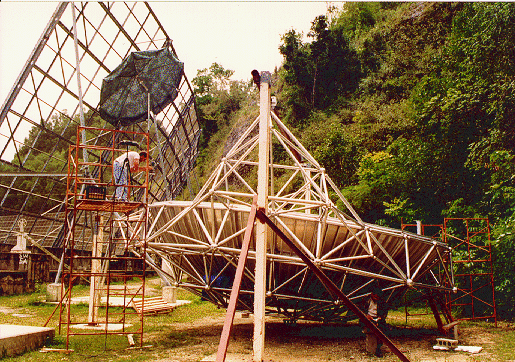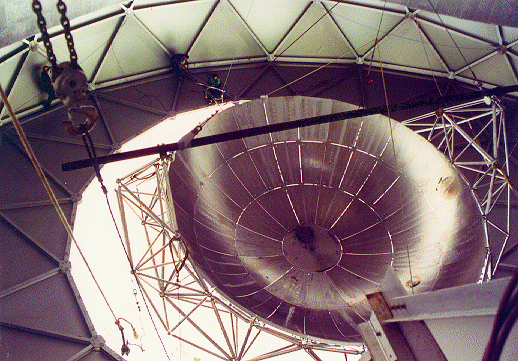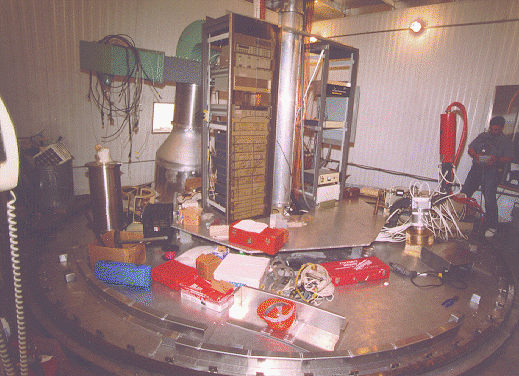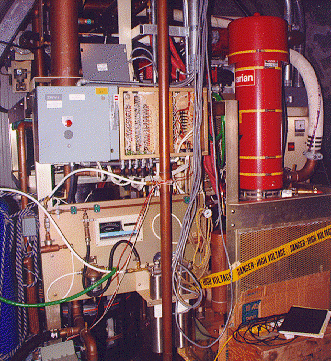
Many of the Arecibo scientific staff volunteered to assemble the tertiary reflector. Here, Mike Davis and Kiriaki Xilouris are shown putting in more than their share of time. Photo by Tony Acevedo.
The telescope's new dual-reflector Gregorian optical system is complete. COMSAT-RSI built the backup structure and 61 panels of the tertiary reflector. These were assembled on site by NAIC personnel and installed in the dome in September. The r.m.s. surface accuracy of the tertiary is approximately 0.5 mm. First noise in the form of a spectrum of galactic HI emission was recorded in early November. Precise focussing will not be possible until the cables are tensioned to bring the suspended structure to its design height.

Many of the Arecibo scientific staff volunteered to assemble
the tertiary reflector. Here, Mike Davis and Kiriaki Xilouris are shown
putting in more than their share of time. Photo by Tony Acevedo.

Lynn Baker, who led the tertiary assembly project, monitoring the surface
accuracy with extensive help from José Víves. Photo by Tony
Acevedo.

The tertiary being lifted through the Gregorian dome aperture. Photo by
Tony Acevedo.
Installation of the new dome, carriage house, and azimuth servo-controlled drive system was completed in July. However, the final commissioning of the drive system is awaiting the final alignment of the elevation and azimuth rails and the realignment of the wheels of the dome elevation trolleys. The carriage house can be moved over its zenith angle range and is being used at 430 MHz for both pulsar searches in drift scan mode and atmospheric radar observations. A corrosion problem has developed in the 18 drive system electric motors. The drive system contractor has indicated that the problem will be fixed by the end of January, 1997.
NAIC is proceeding rapidly with the installation of the mechanical and positioning control systems for the dome rotary receiver room floor, the tertiary reflector, and the platform tiedown cables. The systems for the rotary floor are essentially complete and it is possible to position the floor at the radius of the focal point to approximately 0.5 mm. The tertiary reflector actuators controlling height, "horizontal" position, and tilt are in place. The control system to drive them is undergoing tests and is scheduled to be installed in December. All components for the tiedown system have been procured and the control system has been assembled. Testing and installation will occur after the tertiary system is completed and the tiedown cables have been installed by the contractor.

Inside view of the Gregorian receiver room. The L-band and
the 430-MHz front ends are in place, and the IF/LO racks are installed at
the center of the rotary floor. Ricardo Elías is testing the rotary
floor drive and control system.
Considerable progress has been made in developing and installing instrumentation. Fiber optic links between the operations building and the platform are in place. 21-cm and 70-cm horns and receiver systems have been installed in the dome, and the IF/LO system was also installed and is operational. In the operations building, the new IF distribution system is in the racks in the receiver room, the new VME-based 4-channel, 10-MHz bandwidth A/D converter system is operational and the 4-channel, 50-MHz bandwidth interim digital correlation spectrometer is available for use. Several pulsar search and timing machines, both NAIC-constructed and user-owned-public-access instruments, will be available to users. The new 4-channel, 20-MHz bandwidth, 2,048-lag planetary radar decoder is close to completion.
Installation of the 1-MW, 2,380-MHz S-band transmitter for the planetary radar system has been underway since June. The transmitter is currently undergoing tests and has achieved its design output power. Final acceptance tests for the transmitter are expected in early December. The 2.8-MW turbine generator, which provides the primary power for the transmitter, will also undergo its final acceptance tests in early December.

The S-band transmitter installed inside the Gregorian dome.
Photo by Tony Acevedo.
Copyright 1996, Cornell University
Return to Arecibo Observatory home page.
Generated with Harlequin WebMaker